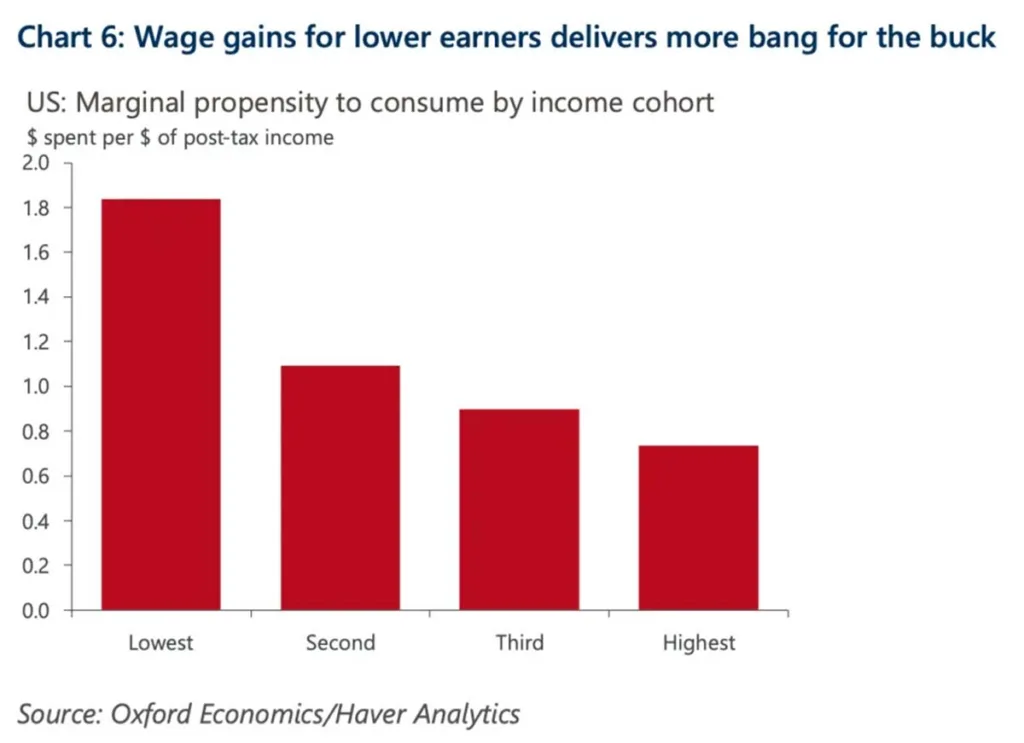The recent plunge in inflation is proving to be a surprising boon for America’s poorest citizens. According to Oxford Economics research, the year-over-year real wage growth adjusted for inflation, saw the most robust increase for the lowest-income earners, reaching around 3% in December. In stark contrast, the highest-income earners experienced just over 1% growth during the same period.
Oxford Economics contends that this trend could play a key role in sustaining resilient consumer spending throughout 2024. Michael Pearce, the lead US economist at Oxford Economics, emphasized the broader implications, stating, “Beyond being good news for low earners, it strengthens optimism about the broader outlook for consumer spending at the margins.” Notably, the lowest quartile of the population, representing 8% of income, possesses a higher propensity to spend, accounting for 13% of overall spending.
Lower-income Americans have particularly benefited from the decrease in food and energy inflation. Oxford Economics points out that inflation rates for these households have declined more sharply than for their higher-earning counterparts. This disparity stems from the fact that lower-income households allocate a larger proportion of their income to food and energy, both of which witnessed marked disinflation in 2023. On the other hand, discretionary services, where lower-income households spend less, exhibited more persistent price gains.
While rental costs contributed significantly to inflationary pressures in the December Consumer Price Index (CPI) report, Pearce anticipates that rental inflation will ease, while energy and food inflation will remain subdued. This outlook aligns with December’s retail sales data, indicating the endurance of consumer resilience. Retail sales surpassed expectations by growing 0.6% in December, with a year-end increase of 4.9% in retail sales, excluding autos and gasoline.

Lydia Boussour, a senior economist at EY, attributes this growth to “solid wage growth” witnessed throughout 2023, and anticipates its positive influence on consumer spending trends into the new year. The sustained income growth exceeding inflation is becoming a pivotal factor in discussions about the possibility of concluding the Federal Reserve’s interest rate hiking campaign without triggering a recession.
Goldman Sachs underscores the importance of income growth, projecting a 2% consumption growth in 2024. This expectation is rooted in the anticipation that real wage growth will remain positive, supported by parallel declines in nominal wage growth and inflation. The economic landscape, according to Goldman Sachs economists, hinges on the equilibrium of robust hiring trends, ample job openings, and a resulting labor income growth of around 2%, translating almost directly to consumer spending.
PEOPLE ALSO READ
AI Wealth Creation Blueprint: The Final Roadmap to Financial Freedom
As the economic narrative unfolds, the unexpected beneficiaries of falling inflation—America’s lowest earners—may play a vital role in shaping the nation’s economic trajectory in the coming year. Oxford Economics’ insights shed light on a nuanced aspect of the economic landscape, offering both reassurance and anticipation for a more equitable and resilient future.
